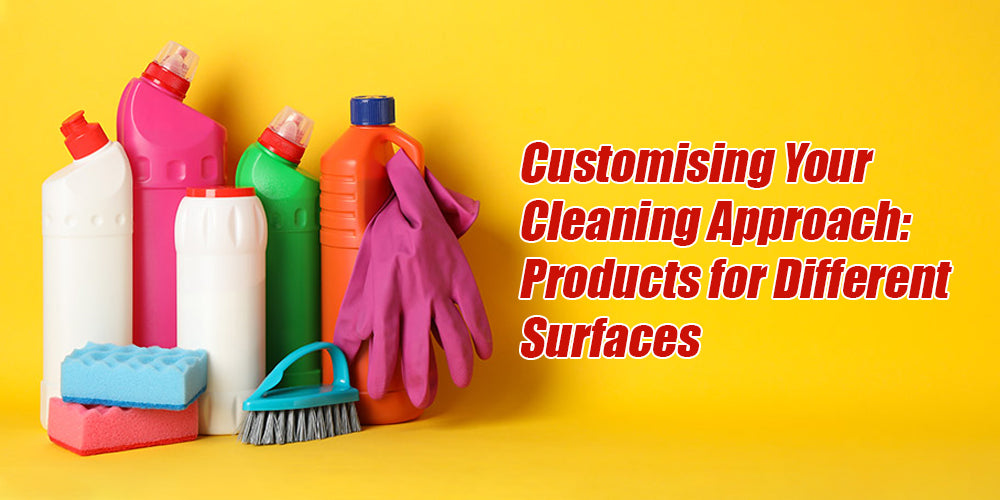Customizing Your Cleaning Approach: Products for Different Surfaces

Cleaning products should be chosen carefully to ensure not only cleanliness but also the integrity of surfaces. Certain surfaces need different maintenance; for example, delicate wooden countertops need to be touched gently, and glass surfaces need to be shined without streaks. Not only does using the incorrect product reduce cleaning effectiveness, but it also puts the surfaces we want to protect at risk. A proper cleaning schedule protects against premature wear, discoloration, and irreversible damage, ensuring longevity. It's important to maintain the beauty and appeal of our surroundings rather than just getting rid of dirt.
This comprehensive guide digs into selecting the right cleaning products for various surfaces, from the delicate care of wood to the pristine upkeep of glass, metal, and fabric. The ideal product preserves the beauty and integrity of our living areas by acting as more than just a tool.
Understanding Surface Variations
Surfaces in our diverse living and working environments encompass an extensive array of materials, each with distinct qualities and care requirements. Recognizing the inherent qualities of various surfaces—such as the comforting qualities of fabrics, the strength of metal, the transparency of glass, and the natural elegance of wood—is essential to maintaining their appeal.
Wood: A Symphony of Natural Beauty
Wooden surfaces, cherished for their warmth and character, beckon a special kind of attention. Whether it's the smoothness of polished furniture or the rustic charm of exposed beams, wood boasts natural grains and finishes that demand delicate care. Its porous nature makes it susceptible to damage from harsh chemicals, necessitating gentle cleaners specifically formulated to nourish and protect its integrity. The art of cleaning wood lies in removing grime and preserving its innate beauty for years to come.
Glass: Clarity in Fragility
Glass surfaces, known for their transparency and elegance, present a paradox—while they reflect immaculate beauty, they easily showcase fingerprints and smudges. Their fragility demands careful handling and specialized cleaners to avoid streaks or scratches. Cleaning glass requires precision, using non-abrasive solutions that not only remove blemishes but restore their pristine clarity without leaving behind any residue.
Metal: Resilience Meets Shine
Metal surfaces, with their versatility and durability, add sophistication to our spaces. However, they are susceptible to tarnishing and corrosion. Tailored cleaning products for metal, capable of removing grime without compromising their luster, are essential. The cleaning process for metals often involves gentle abrasives or non-acidic cleaners to ensure a polished finish without sacrificing resilience.
Fabric: Comfort in Care
Fabrics, whether in upholstery, curtains, or carpets, offer comfort and style. Yet, they harbor hidden dirt and stains that require specific treatments. Cleaning fabric involves more than just surface-level attention. It demands cleaners that penetrate fibers, lifting stains without causing discoloration or damage. Understanding the fabric's composition is crucial for selecting the appropriate cleaning method to maintain its plushness and vibrancy.
These surfaces coexist in the details of our living environments, each with specific needs and vulnerabilities. We must modify our cleaning methods to accommodate the intricate details of wood, glass, metal, and fabric to preserve not merely their natural beauty but also their cleanliness.
Choosing the Right Products
Wood Surfaces: Nurturing Nature's Elegance
Wood surfaces, including furniture and flooring, have a timeless charm that requires gentle care. To preserve this, choose wood-specific cleaners that gently remove dirt and grime while nourishing the wood. Natural oil-based soaps can also add a protective layer, enhancing the wood's resilience. Mild detergents and microfiber cloths can be used for routine cleaning. Avoid abrasive cleaners, as they can compromise the wood's finish and cause scratches or dullness. A gentle cleaning approach ensures the wood's longevity and maintains its natural beauty without compromising its structural integrity.
Glass and Mirrors: Unveiling Crystal Clarity
Glass surfaces and mirrors require careful care to maintain their transparency and clarity. Specialized cleaners and targeted techniques are essential for achieving streak-free results. Vinegar-based solutions and ammonia-based cleaners are effective for removing grime and leaving a streak-free shine. Rubbing alcohol can also be used to tackle fingerprints and other marks. For stubborn stains, baking soda paste can be created, and a razor blade can be used to remove adhesive residue. Avoid abrasive tools and pay attention to fragile areas like edges and frames. Test the cleaner in an unseen area before use to avoid damage.
Metal Surfaces: Polishing Brilliance, Preserving Sheen
Metal surfaces require special care to maintain their luster and aesthetic appeal. To achieve a brilliant shine, use metal-specific cleaners with mild or neutral pH levels. Polishing compounds tailored to different metal types can restore the surface by removing scratches, oxidation, or light corrosion. Pair cleaners or polishing compounds with microfiber cloths or soft brushes for thorough cleaning. Avoid harsh chemicals like strong acids or alkalis, chlorine-based cleaners, and abrasive cleaners. After cleaning, ensure thorough rinsing and drying to prevent water spots or stains. Regular maintenance prevents the buildup of grime or contaminants, preserving the brilliance of metal surfaces.
Fabric and Upholstery: Nurturing Comfort, Protecting Texture
Fabrics and upholstery require special care to maintain their texture and color. To ensure safe cleaning, use fabric-specific cleaners, mild detergents or soap flakes, and foam cleaners. Blotting techniques, gentle brushing, and extractor or steam cleaners are effective methods. Prioritize testing by conducting a spot test in an inconspicuous area before applying any cleaner. Allow the spot test area to dry completely before evaluating the results. Proper cleaning methods and gentle cleaning methods can effectively remove stains from fabric and upholstery while preserving their texture and appeal.
Safety Measures and Tips: Ensuring Safe Cleaning Practices
Cleaning products, while essential for maintaining cleanliness, can contain chemicals that pose risks if mishandled. Implementing proper safety measures is vital to safeguard against accidents and health hazards.
General Safety Precautions
- Read Labels and Instructions: Always read and follow the instructions provided on cleaning product labels. Pay attention to warnings, usage directions, and recommended safety gear.
- Ventilation: Ensure adequate ventilation when using cleaning products, especially those with strong fumes or chemicals. Open windows and doors to allow fresh air to circulate.
- Protective Gear: Use appropriate protective gear such as gloves, masks, and goggles when handling chemicals to protect your skin, eyes, and respiratory system.
- Keep Away from Children and Pets: Store cleaning products out of reach of children and pets. Consider using childproof locks on cabinets where chemicals are stored.
- Avoid Mixing Chemicals: Never mix different cleaning products unless the label specifically indicates it's safe to do so. Mixing chemicals can produce toxic fumes or reactions.
Proper Storage and Handling Practices
- Secure Storage: Store cleaning products in their original containers with tightly sealed lids. Keep them in a cool, dry place away from direct sunlight or heat sources.
- Separate Storage: Store chemicals away from food, beverages, or medications to prevent accidental ingestion or contamination.
- Labelling and Identification: Clearly label containers with the name of the product and its intended use. This helps prevent confusion and accidental misuse.
- Dispose of Wisely: Follow local guidelines for disposing of old or unused cleaning products. Some communities have specific disposal instructions for hazardous materials.
- Emergency Preparedness: Have a plan in place for handling accidental spills or exposure. Keep emergency numbers handy and know the appropriate steps to take in case of an accident.
Additional Tips
- Educate Household Members: Ensure everyone in the household is aware of safety measures and understands the potential risks associated with handling cleaning products.
- Regular Maintenance of Equipment: Check and maintain cleaning equipment regularly to prevent leaks or malfunctions that could lead to accidents.
By adhering to these safety precautions and responsible handling practices, you can minimize the risks associated with using cleaning products, promoting a safer environment for everyone.
Importance of Selecting the Right Cleaning Products
The choice of cleaning products significantly impacts the cleanliness, longevity, and appearance of surfaces in living and working spaces. Each surface has unique characteristics and vulnerabilities that require a tailored cleaning approach. Selzer products preserve surface integrity, enhance cleaning efficiency, and encourage tailored cleaning approaches. Adopting surface-specific techniques optimizes the cleaning process, balancing efficacy and preservation. Customizing the cleaning regimen not only ensures cleanliness but also contributes to the long-term health and aesthetic appeal of the surroundings. In conclusion, the right cleaning products are guardians that preserve the essence and quality of living spaces.
SHARE:

